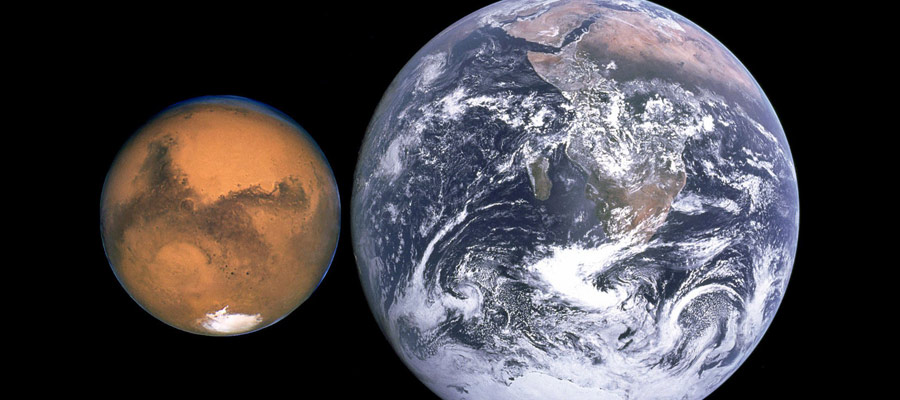
Conditions on Mars
| Diameter: 6.780 km | Earth: 12742 km |
| Rotation: Mars day: 24h : 37min | Earth day: 24h |
| Inclination of rotation axis to the orbit: 25,19° | Earth: 23,44° |
| Revolution time: 687 days | Earth: 365,26 days |
| Sun radiation at Mars orbit: 590W/m2 | Earth orbit: 1370W/m2 |
| Gravitation: 0,38g | Earth: 1,00g |
| Temperature on the equator: -85°c to +20°c, | |
| Total average on Mars: -55°c | Earth +15° |
| Atmosphere: air pressure 6 mbar | Earth sea level: 1.008mba |
| composition: 96% CO2, 1,93% argon, 1,89% nitrogen, 0,146% oxygen, 0,056% CO | Earth: 78,1% nitrogen, 20,9% oxygen, 0,93% argon 0,04% CO2 |
The atmosphere on Mars is very thin so winds do not pose any danger but can churn up a lot of fine dust that can fog the atmosphere over several months. A storm with a wind speed of 360 kmph on Mars has the same impact as wind with 30 kmph on earth.
Cosmic radiation from gamma to UV-radiation as well as solar particle radiation can hit the surface nearly unresisted due to the thin atmosphere and the leak of the magnetic field. The dose is up to 300MeV per year, while it is 0,3 millisieverts only on Earth. The atmosphere onearth shields the radiation with the same effect as a 10 meter thick layer of water, or a 3 meter thick layer of rock material whereas the Mars atmosphere shields like a 6cm thick layer of water only. Meteorites and micrometeorites (>0.2mm in diameter) face very little resistance through the Mars atmosphere only, and hit the surface with a speed of around 25km/s and with an average frequency of 1 pc / m2 and year. At that speed even small particles of 0,3mm in diameter and a mass of 0,06 grams have the impact of an anti-tank bullet.
Essentially a Mars habitat needs to protect its inhabitants from the following adversities:
1. toxicity near to vacuum low-pressure atmosphere
2. extremely low temperatures
3. life threatening cosmic radiation
4. meteorite impacts
Furthermore the mass of transportation inside the spaceship should be as little as possible, and we want to make use of natural sunlight for spacious greenhouses. Greenhouses are important not only for production of food and oxygen through photosynthesis but with vegetation it will be the only natural environment for the inhabitants, who will not be able to leave their habitat more than a few minutes per day in their space suits due to the hard radiation outside. Spending most of the time in a small sterile room without sun and plants could lead to depression.



